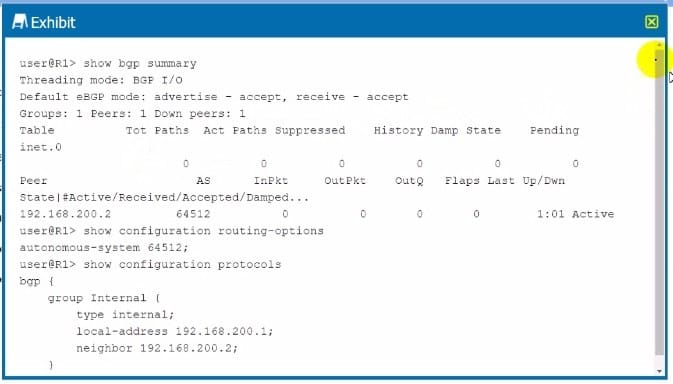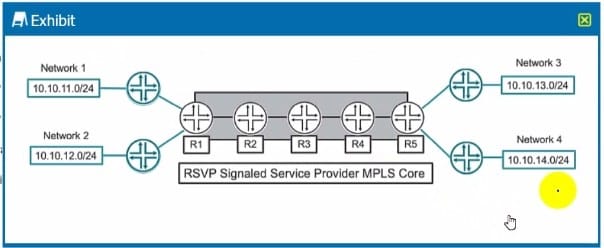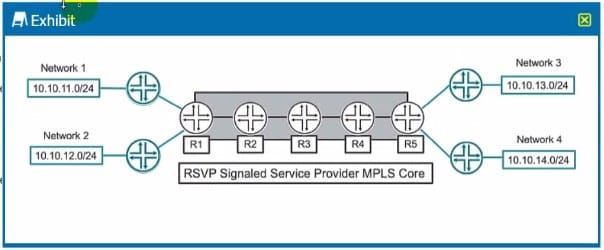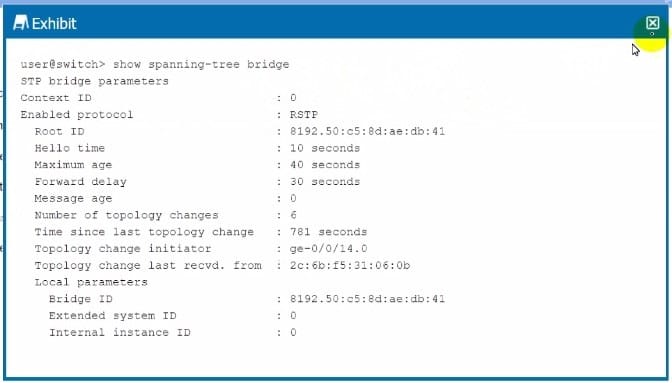Exam Details
Exam Code
:JN0-363Exam Name
:Service Provider Routing and Switching, Specialist (JNCIS-SP)Certification
:Juniper CertificationsVendor
:JuniperTotal Questions
:82 Q&AsLast Updated
:Aug 02, 2025
Juniper Juniper Certifications JN0-363 Questions & Answers
-
Question 1:
What Is a key differentiator of generate routes from aggregate routes?
A. Generate routes use a forwarding next hop.
B. Generate routes have a default next-hop value of reject.
C. Generate routes have a default preference value of 210.
D. Generate routes cannot be used as a gateway of last resort.
-
Question 2:
You want to see a detailed list of all established BGP sessions. In this scenario, what would be a valid command to accomplish this task?
A. show bgp neighbor
B. show bgp summary
C. show rouse receive-protocol bgp
D. show rouse protocol bgp
-
Question 3:
Exhibit.

Referring to the exhibit, you have configured an aggregate route that represents the 172.21.0.0/24, 172.21.1.0/24, and 172.21.2.0/24 networks. However, when you view the routing table, your new route hidden.
Which action would you perform to determine the problem?
A. Verify that you have active contributing routes on the device.
B. Verify that you have configured a policy on the device to accept aggregate routes.
C. Verify that you have defined a metric value for the aggregate route.
D. Verify that you have set the preference to a lower default value.
-
Question 4:
How does a Junos device learn about MAC addresses when II is first connected to an Ethernet LAN?
A. The device sends out a network broadcast message asking tor all devices and MAC addresses on the network and stores this information In addition lo the interface from which the response was received.
B. The device learns the destination MAC addresses from traffic in the network and stores this MAC address in addition to the interface from which the traffic was received.
C. The device learns the source MAC addresses from traffic in the network and stores this MAC address in addition to the interface from which the traffic was received.
D. The device sends out a network multicast message asking for all devices and MAC addresses on the network and stores this Information in addition to the interface from which the response was received.
-
Question 5:
Exhibit

Referring to the exhibit, where should next-hop-self-policy be applied to alter the next-hop value?
A. The policy is applied as an export policy for the group int-64503.
B. The policy is applied as an export policy for the group ext-64501.
C. The policy is applied as an import policy for the group int- 64 503.
D. The policy is applied as an Import policy for the group ext-64501.
-
Question 6:
You are bringing a new network online with three IS-IS routers using default Junos election priorities. The routers are configured as Level 2 only IS-IS routers. Which statement is true about the DIS election in this scenario?
A. The router with the highest MAC address will be elected as the DIS.
B. The router with the highest numerical lo0 IP address will be elected as the DIS.
C. The router with the lowest numerical lo0 IP address will be elected as the DIS.
D. The router with the lowest MAC address will be elected as the DIS.
-
Question 7:
Exhibit You are advertising a summary route that represents your local network (172.20.0.0716) to both ISP A and ISPB. You want to influence all traffic sent to you from ISP C to go through R2. How would you accomplish this task?

A. On R1, prepend your AS number three times on the 172.20.0.0/16 route when advertising It to ISP 1.
B. On R1, change the local preference value to 250.
C. On R2. prepend your AS number three times on the 172.20.0.0/16 route when advertising it to ISP 2.
D. On R2, change the local preference value to 50.
-
Question 8:
Exhibit

Which type of load balancing is shown in the exhibit?
A. elastic load balancing
B. per-packet load balancing
C. per-flow load balancing
D. network load balancing
-
Question 9:
Exhibit

The LSP is not establishing correctly.
Referring to the exhibit, what should you do to solve the problem?
A. Enable traffic engineering for the OSPF protocol.
B. Enable traffic engineering for the IS-IS protocol.
C. Enable traffic engineering for the BGP protocol.
D. Enable traffic engineering for the RSVP protocol.
-
Question 10:
You want to share routes between two routing instances that you have configured?
What are two ways to accomplish this task? (Choose two.)
A. Use a non-forwarding instance.
B. Configure an instance import policy
C. Create a forwarding instance.
D. Use a RIB group.
Related Exams:
JN0-102
Internet Associate, Junos(JNCIA-Junos)JN0-104
Junos, Associate (JNCIA-Junos)JN0-105
Junos, Associate (JNCIA-Junos)JN0-1101
Juniper Networks Certified Design Associate (JNCDA)JN0-1103
Design, Associate (JNCIA-Design)JN0-130
Juniper networks Certified internet specialist.e(jncis-e)JN0-1301
Data Center Design, Specialist (JNCDS-DC)JN0-1302
Data Center Design Specialist (JNCDS-DC)JN0-1331
Security Design, Specialist (JNCDS-SEC)JN0-1332
Security Design, Specialist (JNCDS-SEC)
Tips on How to Prepare for the Exams
Nowadays, the certification exams become more and more important and required by more and more enterprises when applying for a job. But how to prepare for the exam effectively? How to prepare for the exam in a short time with less efforts? How to get a ideal result and how to find the most reliable resources? Here on Vcedump.com, you will find all the answers. Vcedump.com provide not only Juniper exam questions, answers and explanations but also complete assistance on your exam preparation and certification application. If you are confused on your JN0-363 exam preparations and Juniper certification application, do not hesitate to visit our Vcedump.com to find your solutions here.